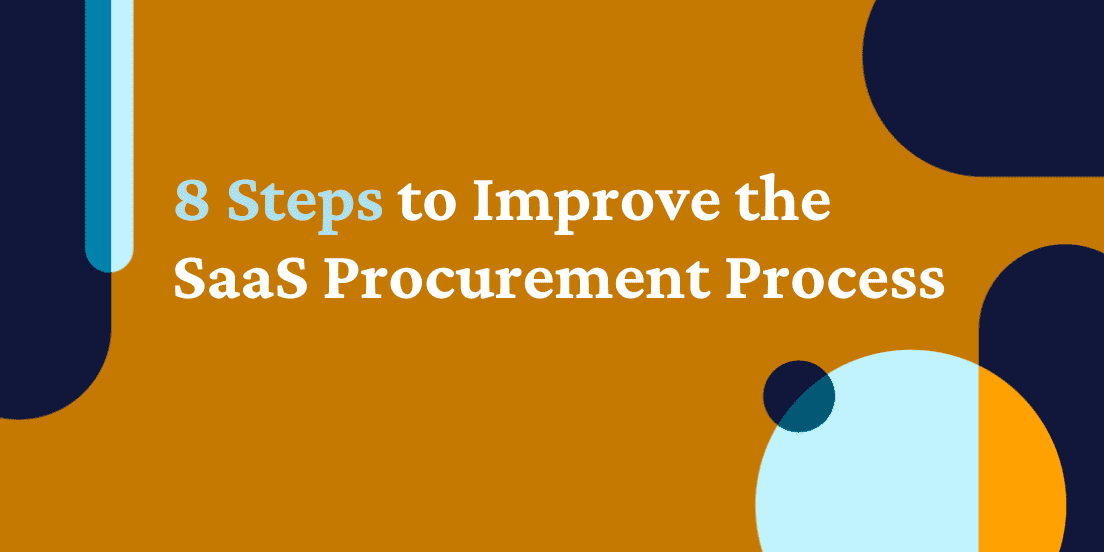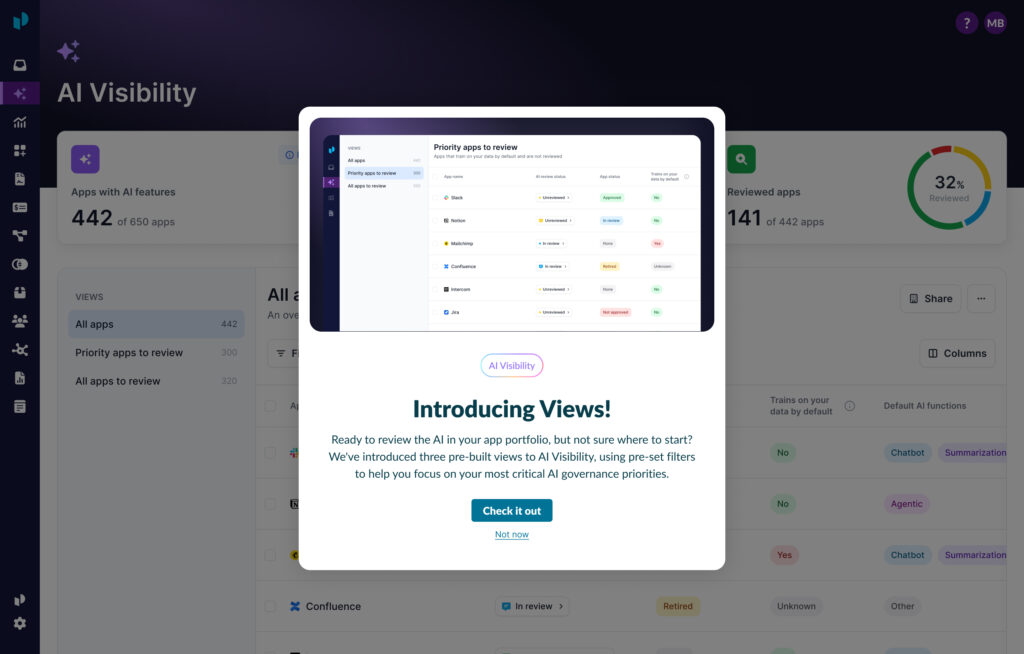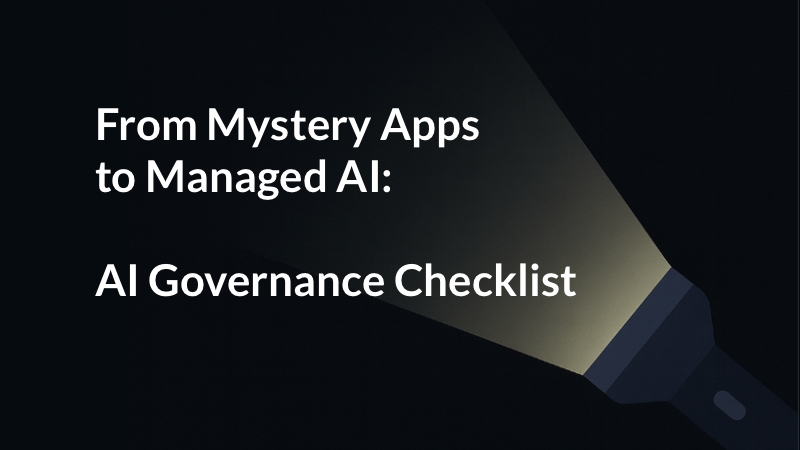
8 steps to improve the SaaS procurement process
The SaaS procurement process is critical for the many cloud-forward companies that exist today. It has the potential to save — or cost — organizations millions of dollars. Unfortunately, it is often tedious and complex, but understanding the right steps to streamline your systems can turn your journey into a frictionless procurement process.
What is SaaS procurement?
SaaS procurement refers to the purchases and renewing software as a service (SaaS) applications. This is software that is provided and maintained by a third-party vendor over the internet, rather than being installed and run on local computers.
What is the SaaS procurement process?
The process of procuring SaaS typically begins with identifying a specific business need or opportunity that the SaaS solution will address. This is followed by research and evaluation of different solutions, to determine which one is the best fit for the organization’s needs.
Once a solution has been selected, the vendor is contacted and the process moves on to negotiation of the terms of the agreement, which includes pricing, service level agreements, and other important details.
After the agreement has been signed, the solution is implemented and configured to meet the organization’s specific needs. Ongoing management of the solution is necessary, including monitoring usage, troubleshooting issues with the vendor, and making configuration updates as necessary.
The whole process is intended to provide the organization with a cost-effective way of accessing software and technology without the need to invest in expensive hardware and infrastructure.

What does a SaaS Management Platform look like?
What are the challenges organizations face with SaaS procurement?
- Lack of standardization
- Difficulty in comparing different solutions
- Complexity of integration
- Security and compliance concerns
- Lack of control
- Challenges in contract negotiations
- Aligning internal stakeholders
Lack of standardization in the constantly evolving SaaS market
There is a lack of standardization in the constantly evolving SaaS market because new solutions and vendors are constantly entering the market. Additionally, industry regulations and expectations are always changing. This makes it challenging for procurement leaders to keep up with the latest developments and ensure that they are selecting the best solutions for their organization.
This lack of standardization makes it difficult for procurement teams to:
- Evaluate and compare different solutions as there is no common set of standards or guidelines to follow
- Ensure solutions meet the organization’s needs and are compatible with existing systems and processes
- Forecast future costs and budget for SaaS solutions
- Ensure SaaS solutions comply with necessary regulations
Difficulty in comparing different solutions due to diverse features and capabilities
It seems as if every app has unique and varying levels of functionality. And while this increases the chance that there is a solution that fits your use case just right, it can also make finding that solution more difficult. If you are in the early stages of evaluating tools in a category for the first time, these diverse features and capabilities can make comparisons strenuous.
For example, one app may be focused on a specific task, like invoicing, while another may have a wider range of features, like project management and time tracking. When should you get three apps that do three different things versus one app that does three different things? The answer won’t always be the same.
Additionally, different solutions may have different levels of scalability, ease of use, security and compliance, integrations, customization options, and support. Moreover, similar vendors may have different pricing models, contract terms, and service level agreements. Procurement leaders need to take all these factors into account when comparing solutions and determining which one is the best fit for their organization.
Complexity of integration and customization of SaaS solutions
The integration and customization associated with SaaS apps can be complex and will sometimes require a high level of technical expertise and careful planning. Procurement leaders need to take into account the technical requirements, data migration, interoperability, customization, scalability, and API integration when evaluating and implementing SaaS solutions.
You may need to work closely with IT teams to ensure that apps are properly integrated and configured to meet your organization’s specific needs. If you’re replacing an existing system with a SaaS solution, moving large amounts of data between the two can be time consuming and prone to error.
Speaking of data, some SaaS solutions may only offer API integration and not have pre-built integrations, which can make integration and customization more difficult as it may require more technical knowledge and resources.
The interoperability of on-premises systems and SaaS solutions varies greatly. You may find it difficult to integrate multiple solutions together into a cohesive system. Knowing these limitations during the evaluation processes can help you plan for these challenges or find other solutions that connect more easily.
Some SaaS solutions are more customizable than others, which can be a challenge for organizations that need to tailor the solution to their specific needs. If you expect to grow quickly, ensure the solution you’re investing in can scale to accommodate that growth.
Security and compliance concerns with storing sensitive data in the cloud
You’ll want to ensure that the SaaS solutions you choose have robust security measures in place, comply with industry regulations, and are aligned with your organization’s internal security policies.
Some solutions may process and store sensitive data, such as personal information, in different countries, which can raise data privacy concerns. Check to see if the vendor’s data processing and storage practices comply with local and international data privacy regulations, such as GDPR and CCPA. You’ll also want to understand the app’s encryption and access controls to protect against data breaches.
In some industries, such as healthcare and financial services, there are specific regulations that organizations must comply with in regards to data storage and processing. And, of course, you’ll need to stay compliant with internal security policies as well.
Lastly, storing data in the cloud also increases the risk of data loss, particularly in the event of a disaster or a failure of the SaaS solution. Ask the vendor about what disaster recovery plans it has in place to ensure that data is properly backed up.
Lack of control over the solution as it is maintained by a third-party vendor
Whenever you go with a third-party vendor for a solution, you forfeit some control as you rely on the vendor for support and updates. You can’t always ensure the solution will be available and running smoothly and resolution of those issues will depend on the vendor’s response time.
Additionally, your ability to customize the solution to meet your unique needs will vary from vendor to vendor. And if industry regulations or your security policies change, you may not be able to ensure compliance for the SaaS applications you use.
As SaaS vendors continue to develop their products and services, the cost of their solutions is likely to change as well. This can make it difficult to forecast future costs and budget associated with SaaS applications.
Challenges in contract negotiations and management of vendors
Organizations lean heavily on procurement leaders to negotiate the best terms at the best price with vendors. But it can be difficult to gain access to the data and insights needed to get a leg up in vendor negotiations.
Negotiating favorable terms with vendors, including pricing, service level agreements, and termination clauses is a complex and time-consuming process, especially if the vendor is not willing to be flexible. And you don’t want to burn bridges in the process. Building rapport with vendors can go a long way in improving their responsiveness to issues in the future.
Another part of SaaS vendor management is regularly reviewing and updating contracts to reflect any changes in your organization’s needs or the vendor’s offering and ensuring compliance when changes do happen. Procurement leaders also need to hold vendors accountable to the performance requirements and service levels specified in the contract.
Aligning internal stakeholders across the review and approval process
Aligning stakeholders across departments requires a lot of effort, especially when different departments tend to have different systems and data sets they rely on to make decisions.
During the intake process, each department may have different requirements and priorities, which can create confusion and slow down the decision-making process. Additionally, different stakeholders may have different levels of expertise and understanding of the technology, leading to disagreements and delays.
The same challenges can arise during renewals, where multiple departments may need to review and approve the contract renewal. The time spent setting up and conducting meetings, gathering and analyzing data, and orchestrating reviews across multiple systems takes away valuable time from the negotiation process.
Here are several steps that you can take to improve the SaaS procurement process.
1. Define business requirements
Before beginning the procurement process, define clear business requirements for the SaaS solution. This will help to ensure that the solution meets your specific needs and will make it easier to evaluate different solutions.
2. Set evaluation criteria
Create a comprehensive list of evaluation criteria that SaaS solutions need to meet. This will help to ensure that all important features and capabilities are taken into account when evaluating and comparing different solutions.
3. Involve relevant stakeholders
Involve the relevant stakeholders in the procurement process, such as IT, finance, and business teams. Each team will have their own expertise to bring to the evaluation process.
4. Utilize third-party software evaluation tools
If you’re not sure you have the capacity to perform an effective evaluation internally, there are third-party software evaluation tools you can use to compare different solutions and help ensure you are getting the best value for your organization.
5. Assess vendor risk
Perform due diligence on the vendor before signing a contract. There are many factors for assessing vendor risk, including security, compliance, reputation, and financial stability.
6. Create a comprehensive contract
Develop an exhaustive contract that covers all necessary elements such as pricing, terms, service level agreements, support, liability, privacy, and more.
7. Develop a forward-looking plan
Develop a plan for ongoing management of the SaaS solution, including monitoring usage, troubleshooting issues with the vendor, and making configuration updates as necessary.
8. Regularly review and update contracts
Review and update the contract regularly to ensure that it reflects any changes in your needs or the vendor’s offering.
How SaaS Management helps with SaaS procurement
While helpful, those best practices provided above can prove difficult to manage. A SaaS Management Platform can help you by providing a central location to manage and review contracts; track app usage, spend, and compliance; and streamline procurement.
Manage and review contracts
SMPs can provide you with a centralized place for contract and vendor management. Leveraging integrations with contract management and file management systems, as well as ingestion services and manual uploads, you can standardize your contracts for easy insights and analysis.
From there, you can track all SaaS contract terms, app contacts, license usage, and more in one place. You can also get the added benefit of an automatic renewal calendar with built-in alerts and notifications so you can avoid service disruptions, unplanned auto-renewals, and surprise true-ups.
Track app usage, spend, and compliance
SaaS Management Platforms also enable you to automatically discover and inventory all the SaaS applications your organization uses, including shadow IT, to provide you with a complete view of your SaaS portfolio.
Drilling down deeper, you can measure the usage and spend associated with each application. This will help you understand if the SaaS licenses you’ve provisioned are actually being used and, if an application has tiered licenses, if license types are being efficiently allocated.
These insights are invaluable for deciding how many licenses to renew at. You may also be able to determine that an application is no longer needed based on low license utilization. You can also compare the solutions you have in a similar category and make plans for consolidation.
By viewing application spend by team, you can paint a more accurate picture of headcount count per department and better forecast spend based on growth plans. This will also help you identify high-spend, low-utilization applications that you may want to consider retiring.
Additionally, this complete view of your SaaS portfolio can help you track the compliance certifications for each application to better understand your security and compliance posture and make plans to remedy any issues.

What does a SaaS Management Platform look like?
About Productiv:
Productiv is the IT operating system to manage your entire SaaS and AI ecosystem. It centralizes visibility into your tech stack, so CIOs and IT leaders can confidently set strategy, optimize renewals, and empower employees.





